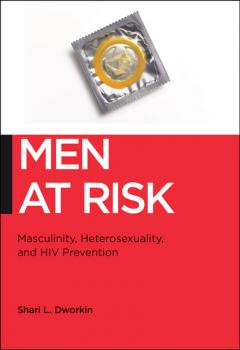ТОП просматриваемых книг сайта:
Biopolitics
Скачать книги из серии BiopoliticsАннотация
Watch Georgiann Davis in National Geographic's Gender Revolution documentary with Katie Couric A personal, compelling perspective on how medical diagnoses can profoundly hurt, or help, the lived experiences of entire communities Winner, 2017 Sex and Gender Distinguished Book Award, presented by the American Sociological Association Winner, 2016 Donald Light Award for the Applied or Public Practice of Medical Sociology, presented by the American Sociological Association When sociologist Georgiann Davis was a teenager, her doctors discovered that she possessed XY chromosomes, marking her as intersex. Rather than share this information with her, they withheld the diagnosis in order to “protect” the development of her gender identity; it was years before Davis would see her own medical records as an adult and learn the truth. Davis’ experience is not unusual. Many intersex people feel isolated from one another and violated by medical practices that support conventional notions of the male/female sex binary which have historically led to secrecy and shame about being intersex. Yet, the rise of intersex activism and visibility in the US has called into question the practice of classifying intersex as an abnormality, rather than as a mere biological variation. This shift in thinking has the potential to transform entrenched intersex medical treatment. In Contesting Intersex, Davis draws on interviews with intersex people, their parents, and medical experts to explore the oft-questioned views on intersex in medical and activist communities, as well as the evolution of thought in regards to intersex visibility and transparency. She finds that framing intersex as an abnormality is harmful and can alter the course of one’s life. In fact, controversy over this framing continues, as intersex has been renamed a ‘disorder of sex development’ throughout medicine. This happened, she suggests, as a means for doctors to reassert their authority over the intersex body in the face of increasing intersex activism in the 1990s and feminist critiques of intersex medical treatment. Davis argues the renaming of ‘intersex’ as a ‘disorder of sex development’ is strong evidence that the intersex diagnosis is dubious. Within the intersex community, though, disorder of sex development terminology is hotly disputed; some prefer not to use a term which pathologizes their bodies, while others prefer to think of intersex in scientific terms. Although terminology is currently a source of tension within the movement, Davis hopes intersex activists and their allies can come together to improve the lives of intersex people, their families, and future generations. However, for this to happen, the intersex diagnosis, as well as sex, gender, and sexuality, needs to be understood as socially constructed phenomena. A personal journey into medical and social activism, Contesting Intersex presents a unique perspective on how medical diagnoses can affect lives profoundly. Ask us about setting up a Skype-in with the author for your class
Информация о книге
Автор произведения Georgiann Davis
Жанр Управление, подбор персонала
Серия Biopolitics
Аннотация
Although the first AIDS cases were attributed to men having sex with men, over 70% of HIV infections worldwide are now estimated to occur through sex between women and men. In Men at Risk, Shari L. Dworkin argues that the centrality of heterosexual relationship dynamics to the transmission of HIV means that both women and men need to be taken into account in gender-specific HIV/AIDS prevention interventions. She looks at the “costs of masculinity” that shape men’s HIV risks, such as their initiation of sex and their increased status from sex with multiple partners. Engaging with the common paradigm in HIV research that portrays only women—and not heterosexually active men—as being “vulnerable” to HIV, Dworkin examines the gaps in public health knowledge that result in substandard treatment for HIV transmission and infection among heterosexual men both domestically and globally. She examines a vast array of structural factors that shape men’s HIV transmission risks and also focuses on a relatively new category of global health programs with men known as “gender-transformative” that seeks to move men in the direction of gender equality in the name of improved health. Dworkin makes suggestions for the next generation of gender-transformative health interventions by calling for masculinities-based and structurally driven HIV prevention programming. Thoroughly researched and theoretically grounded, Men at Risk presents a unique approach to HIV prevention at the intersection of sociological and public health research.
Аннотация
Winner of the 2014 Diamond Anniversary Book Award Finalist for the 2014 National Communications Association Critical and Cultural Studies Division Book of the Year Award In 2000, the National Human Genome Research Institute announced the completion of a “draft” of the human genome, the sequence information of nearly all 3 billion base pairs of DNA. Since then, interest in the hereditary basis of disease has increased considerably. In The Material Gene, Kelly E. Happe considers the broad implications of this development by treating “heredity” as both a scientific and political concept. Beginning with the argument that eugenics was an ideological project that recast the problems of industrialization as pathologies of gender, race, and class, the book traces the legacy of this ideology in contemporary practices of genomics. Delving into the discrete and often obscure epistemologies and discursive practices of genomic scientists, Happe maps the ways in which the hereditarian body, one that is also normatively gendered and racialized, is the new site whereby economic injustice, environmental pollution, racism, and sexism are implicitly reinterpreted as pathologies of genes and by extension, the bodies they inhabit. Comparing genomic approaches to medicine and public health with discourses of epidemiology, social movements, and humanistic theories of the body and society, The Material Gene reworks our common assumption of what might count as effective, just, and socially transformative notions of health and disease.
Информация о книге
Автор произведения Kelly E. Happe
Жанр Управление, подбор персонала
Серия Biopolitics
Аннотация
From the clamshell razors and homemade lye depilatories used in colonial America to the diode lasers and prescription pharmaceuticals available today, Americans have used a staggering array of tools to remove hair deemed unsightly, unnatural, or excessive. This is true especially for women and girls; conservative estimates indicate that 99% of American women have tried hair removal, and at least 85% regularly remove hair from their faces, armpits, legs, and bikini lines. How and when does hair become a problem—what makes some growth “excessive”? Who or what separates the necessary from the superfluous? In Plucked, historian Rebecca Herzig addresses these questions about hair removal. She shows how, over time, dominant American beliefs about visible hair changed: where once elective hair removal was considered a “mutilation” practiced primarily by “savage” men, by the turn of the twentieth century, hair-free faces and limbs were expected for women. Visible hair growth—particularly on young, white women—came to be perceived as a sign of political extremism, sexual deviance, or mental illness. By the turn of the twenty-first century, more and more Americans were waxing, threading, shaving, or lasering themselves smooth. Herzig’s extraordinary account also reveals some of the collateral damages of the intensifying pursuit of hair-free skin. Moving beyond the experiences of particular patients or clients, Herzig describes the surprising histories of race, science, industry, and medicine behind today's hair-removing tools. Plucked is an unsettling, gripping, and original tale of the lengths to which Americans will go to remove hair.
Информация о книге
Автор произведения Rebecca M. Herzig
Жанр Управление, подбор персонала
Серия Biopolitics
Аннотация
Phantom limb pain is one of the most intractable and merciless pains ever known—a pain that haunts appendages that do not physically exist, often persisting with uncanny realness long after fleshy limbs have been traumatically, surgically, or congenitally lost. The very existence and “naturalness” of this pain has been instrumental in modern science’s ability to create prosthetic technologies that many feel have transformative, self-actualizing, and even transcendent power. In Phantom Limb, Cassandra S. Crawford critically examines phantom limb pain and its relationship to prosthetic innovation, tracing the major shifts in knowledge of the causes and characteristics of the phenomenon. Crawford exposes how the meanings of phantom limb pain have been influenced by developments in prosthetic science and ideas about the extraordinary power of these technologies to liberate and fundamentally alter the human body, mind, and spirit. Through intensive observation at a prosthetic clinic, interviews with key researchers and clinicians, and an analysis of historical and contemporary psychological and medical literature, she examines the modernization of amputation and exposes how medical understanding about phantom limbs has changed from the late-19th to the early-21st century. Crawford interrogates the impact of advances in technology, medicine, psychology and neuroscience, as well as changes in the meaning of limb loss, popular representations of amputees, and corporeal ideology. Phantom Limb questions our most deeply held ideas of what is normal, natural, and even moral about the physical human body.
Аннотация
We know more about the physical body—how it begins, how it responds to illness, even how it decomposes—than ever before. Yet not all bodies are created equal, some bodies clearly count more than others, and some bodies are not recognized at all. In Missing Bodies , Monica J. Casper and Lisa Jean Moore explore the surveillance, manipulations, erasures, and visibility of the body in the twenty-first century. The authors examine bodies, both actual and symbolic, in a variety of arenas: pornography, fashion, sports, medicine, photography, cinema, sex work, labor, migration, medical tourism, and war. This new politicsof visibility can lead to the overexposure of some bodies—Lance Armstrong, Jessica Lynch—and to the near invisibility of others—dead Iraqi civilians, illegal immigrants, the victims of HIV/AIDS and «natural» disasters. Missing Bodies presents a call for a new, engaged way of seeing and recovering bodies in a world that routinely, often strategically,obscures or erases them. It poses difficult, even startling questions: Why did it take so long for the United States media to begin telling stories about the «falling bodies» of 9/11? Why has the United States government refused to allow photographs or filming of flag-draped coffins carrying the bodies of soldiers who are dying in Iraq? Why are the bodies of girls and women so relentlessly sexualized? By examining the cultural politics at work in such disappearances and inclusions of the physical body the authors show how the social, medical and economic consequences of visibility can reward or undermine privilege in society.
Аннотация
Heart disease, the leading cause of death in the United States, affects people from all walks of life, yet who lives and who dies from heart disease still depends on race, class, and gender. While scientists and clinicians understand and treat heart disease more effectively than ever before, and industrialized countries have made substantial investments in research and treatment over the past six decades, patterns of inequality persist. In Heart-Sick, Janet K. Shim argues that official accounts of cardiovascular health inequalities are unconvincing and inadequate, and that clinical and public health interventions grounded in these accounts ignore many critical causes of those inequalities. Examining the routine activities of epidemiology—grant applications, data collection, representations of research findings, and post-publication discussions of the interpretations and implications of study results—Shim shows how social differences of race, social class, and gender are upheld by the scientific community. She argues that such sites of expert knowledge routinely, yet often invisibly, make claims about how biological and cultural differences matter—claims that differ substantially from the lived experiences of individuals who themselves suffer from health problems. Based on firsthand research at epidemiologic conferences, conversations with epidemiologists, and in-depth interviews with people of color who live with heart disease, Shim explores how both scientists and lay people define “difference” and its consequences for health. Ultimately, Heart-Sick explores the deep rifts regarding the meanings and consequences of social difference for heart disease, and the changes that would be required to generate more convincing accounts of the significance of inequality for health and well-being.
Аннотация
A Hindu monk in Calcutta refuses to take his psychotropic medications. His psychiatrist explains that just as his body needs food, the drugs are nutrition for his starved mind. Does it matter how—or whether—patients understand their prescribed drugs? Millions of people in India are routinely prescribed mood medications. Pharmaceutical companies give doctors strong incentives to write as many prescriptions as possible, with as little awkward questioning from patients as possible. Without a sustained public debate on psychopharmaceuticals in India, patients remain puzzled by the notion that drugs can cure disturbances of the mind. While biomedical psychopharmaceuticals are perceived with great suspicion, many non-biomedical treatments are embraced. Stefan Ecks illuminates how biomedical, Ayurvedic, and homeopathic treatments are used in India, and argues that pharmaceutical pluralism changes popular ideas of what drugs do. Based on several years of research on pharmaceutical markets, Ecks shows how doctors employ a wide range of strategies to make patients take the remedies prescribed. Yet while metaphors such as «mind food» may succeed in getting patients to accept the prescriptions, they also obscure a critical awareness of drug effects. This rare ethnography of pharmaceuticals will be of key interest to those in the anthropology and sociology of medicine, pharmacology, mental health, bioethics, global health, and South Asian studies.
Аннотация
You see someone smoking a cigarette and say,“Smoking is bad for your health,” when what you mean is, “You are a bad person because you smoke.” You encounter someone whose body size you deem excessive, and say, “Obesity is bad for your health,” when what you mean is, “You are lazy, unsightly, or weak of will.” You see a woman bottle-feeding an infant and say,“Breastfeeding is better for that child’s health,” when what you mean is that the woman must be a bad parent. You see the smokers, the overeaters, the bottle-feeders, and affirm your own health in the process. In these and countless other instances, the perception of your own health depends in part on your value judgments about others, and appealing to health allows for a set of moral assumptions to fly stealthily under the radar. Against Health argues that health is a concept, a norm, and a set of bodily practices whose ideological work is often rendered invisible by the assumption that it is a monolithic, universal good. And, that disparities in the incidence and prevalence of disease are closely linked to disparities in income and social support. To be clear, the book's stand against health is not a stand against the authenticity of people's attempts to ward off suffering. Against Health instead claims that individual strivings for health are, in some instances, rendered more difficult by the ways in which health is culturally configured and socially sustained.The book intervenes into current political debates about health in two ways. First, Against Health compellingly unpacks the divergent cultural meanings of health and explores the ideologies involved in its construction. Second, the authors present strategies for moving forward. They ask, what new possibilities and alliances arise? What new forms of activism or coalition can we create? What are our prospects for well-being? In short, what have we got if we ain't got health? Against Health ultimately argues that the conversations doctors, patients, politicians, activists, consumers, and policymakers have about health are enriched by recognizing that, when talking about health, they are not all talking about the same thing. And, that articulating the disparate valences of “health” can lead to deeper, more productive, and indeed more healthy interactions about our bodies.
Аннотация
A critical study of diabetes in the popular imagination Over twenty-nine million people in the United States, more than nine percent of the population, have some form of diabetes. In Managing Diabetes, Jeffrey A. Bennett focuses on how the disease is imagined in public culture. Bennett argues that popular anecdotes, media representation, and communal myths are as meaningful as medical and scientific understandings of the disease. In focusing on the public character of the disease, Bennett looks at health campaigns and promotions as well as the debate over public figures like Sonia Sotomayor and her management of type 1 diabetes. Bennett examines the confusing and contradictory public depictions of diabetes to demonstrate how management of the disease is not only clinical but also cultural. Bennett also has type 1 diabetes and speaks from personal experience about the many misunderstandings and myths that are alive in the popular imagination. Ultimately, Managing Diabetes offers a fresh take on how disease is understood in contemporary society and the ways that stigma, fatalism, and health can intersect to shape diabetes’s public character. This disease has dire health implications, and rates keep rising. Bennett argues that until it is better understood it cannot be better treated.










